External Reference Material
Page 1 ~ Page 2 ~ Page 3 ~ Page 4 ~ Page 5 ~ Page 6
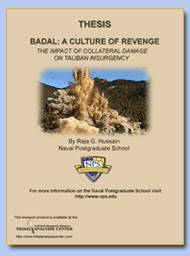 BADAL:
BADAL:
A Culture of Revenge The Impact of Collateral Damage on Taliban Insurgency
BY: Raja G. Hussain LT, USN
March 2008
96 PAGES - 1.3MB
This thesis examines the impact of collateral damage on the Taliban insurgency. It reveals the relationship between death of innocent civilians and the tribal concept of badal (revenge). Research also analyzes Taliban propaganda leaflets to illustrate the compromise of popular support caused by collateral damage stemming from the Coalition’s tactics. Research probes into the historical Anglo-Afghan wars and the 1979 Soviet invasion to draw parallels to the current insurgency. In doing so, it highlights the rising role of religion and FATA, Pakistan. FATA is analyzed to show the effects of intrusions by outside actors as well as historical and recent events that have shaped the populace and structure of these tribal regions. Lastly, the research concludes by offering non-kinetic solutions to curbing the Taliban insurgency. The solutions focus on FATA and offer socio-economic and political remedies to hinder with the Taliban recruitment efforts and cross-border incursions. Thesis recognizes FATA and reduction in collateral damage as pivotal factors to fostering stability in the region.
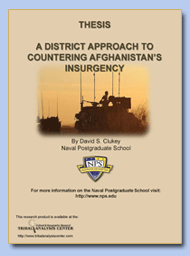 A DISTRICT APPROACH TO COUNTERING
A DISTRICT APPROACH TO COUNTERING
AFGHANISTAN’S INSURGENCY
BY: David S. Clukey MAJ, USA
December 2009
138 PAGES - 1.61MB
Since the initial invasion and ousting of the Taliban regime in 2001, International Security Assistance Forces (ISAF) and the United States (U.S.) military have lost the initiative and become sedentary in Afghanistan. This case study analysis considers if ISAF and the U.S. military are appropriately employing the current disposition of military forces to maximize effects against the insurgency in Afghanistan. This study objectively compares and contrasts the current ISAF and U.S. strategy with a district level FID/COIN methodology. This study explores why it is necessary to approach the problem at the district/village level to enhance the security, control, and influence of the Islamic Republic of Afghanistan (IRoA), and to eliminate systematically the conditions that have supported the insurgency in Afghanistan.
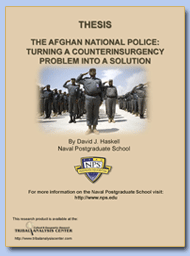 THE AFGHAN NATIONAL POLICE:
THE AFGHAN NATIONAL POLICE:
TURNING A COUNTERINSURGENCY PROBLEM INTO A SOLUTION
BY: David J. Haskell. MAJ, USA
December 2009
120 PAGES - 1.44MB
The Taliban have managed to expand their political and military influence every year for the last five years, and if this trend is not stopped and ultimately reversed, the government of Afghanistan will likely collapse. While there is not one solution for victory in Afghanistan, some counterinsurgency precepts are more critical than others. This thesis examines and explains why legitimate police are vital to defeating the Taliban insurgency. Additionally, this thesis identifies and seeks to validate two key recommendations for improving the legitimacy and effectiveness of the Afghan National Police. First, the International Security Assistance Force (ISAF) and the Government of the Islamic Republic of Afghanistan (GIRoA) need to make the Afghan National Police their number one priority for resources and manpower. Second, the Afghan National Police must be fundamentally restructured in accordance with traditional and cultural precepts to meet the needs of rural Afghan communities. Tailoring police reform to meet the needs of rural Afghans can reverse the Taliban’s influence and legitimacy in Afghanistan’s critical periphery.
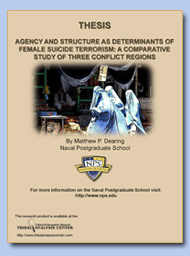 AGENCY AND STRUCTURE AS DETERMINANTS OF FEMALE SUICIDE
AGENCY AND STRUCTURE AS DETERMINANTS OF FEMALE SUICIDE
TERRORISM: A COMPARATIVE STUDY OF THREE CONFLICT REGIONS
BY: Matthew P. Dearing CIV, USN
December 2009
174 PAGES - 1.47MB
This thesis addresses the question, why do some insurgent groups use female suicide bombers while others avoid this tactic? Afghanistan is an example of a conflict zone where the propensity for female suicide terrorism is lower than other conflict regions, such as Iraq and Sri Lanka. Strategic calculations and materialist gains play a unique role in influencing organizational behavior, but deeper structural considerations such as norms, institutional barriers, and the dynamics of conflict also influence the agency of actors. Realist approaches provide limited explanatory power in addressing the variation in the use of female suicide terrorism; constructivism provides a better model toward addressing individual, organizational and societal acceptance of this tactic, particularly as it relates to women. The case of the Taliban insurgency and its limited use of female suicide bombers suggest that factors other than materialist imperatives are at play. The comparative study of female suicide bombings has immediate policy and counterterrorism implications, but it can also shed light on the debate between materialist and constructivist approaches in international relations theory and in the formulation of military doctrine.

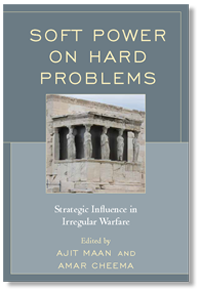

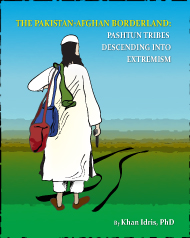
 The Private Journal of
The Private Journal of